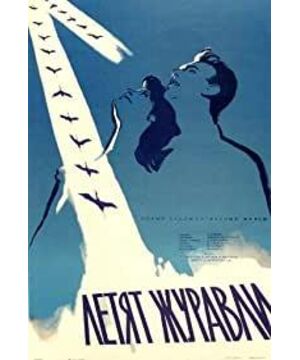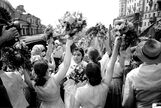It can be said that this film has a perfect script and technique. Although the shallow performance in the layout and aesthetic form is not the peak of Kalatozov, it is undoubtedly my favorite one! The whole film has a touch of sadness and emotional changes. The perfect use of mature techniques and the regular structure of the play are deeply convincing. The expression and sublimation of the final ideology was criticized by many film critics, but there was absolutely no preoccupation, which was in line with the people-oriented tone of the film. Veronica's crying and the loss of her lover and the crowd's laughing or crying to greet her family are completely counterpoints and means of contrast, which shows that the film returns to people's consciousness.
In the camera movement, Kalatozov is still so precise that he seems to enjoy following the spiral movement of the figures in the stairwell, creating a sense of urgency and desire. When the crowd is crowded, the camera travels through the crowd, so that the camera becomes the human eye to look for to enhance the sense of immersion. Black and white film increases the contrast, enhances the layering and details of the picture, and also makes the light control and lighting of the film more prominent and more stylized.
As for the poetic part, of course, long shots are inseparable. Although long shots are not the only ones in expressing poetic films, traditionally the poetic tradition that belongs to the Soviet Union is always inseparable from the techniques of long shots. Russians probably have a tradition of reading poetry, and their nation has also produced many great poets in history, and the aesthetics of poetry can be said to exist in their bones. Therefore, in the expression of the film text, poetic lines and narrations full of rich emotions often linger around the image, weakening the visual impact or keeping pace with it, making this "poetry" text obtain a vassal status beyond the image. , thus creating the unique and inherent style of this Soviet poetic film.
What is strange is that although the expression of the "poetry" text was not so obvious in 1957's "Yan Nanfei", it was abundantly displayed in "I Am Cuba" in 1964. The burden of expression in the poem "Flying Wild Goose" is entirely placed on the image and sound. The most obvious one is that after Boris joined the army, Veronica learned in the telephone booth that she had not received a letter from her lover. In my opinion, the series of scenes in which Mark took over as his wife and Boris was shot down is the most dazzling scene in "The Wild Goose".
In that scene, the film is narrated in parallel in time and space, and the means of superposition are used extensively, so that time and space are cross-linked, and both sound and picture have a strong symbolic connection. For example, the clicking sound of Mark picking up Veronica and walking on the shattered glass and the sticky sound of Boris walking in the swamp with his comrades in arms, the former is that Boris's love is dying, and the latter indicates that In the future, even if the war is won, Veronica's love will die, not to mention the rich superimposed image of Boris before his fall, fantasizing about his beautiful vision, but unfortunately it will always remain in his mind. , his ignorance may not hurt him so much. The disabled soldier who lost his love in the field hospital is a typical example of suffering.
In terms of music and sound effects, a harmonious unity has also been achieved. When the air strike hit, Mark hypocritically said that he would stay by Veronica's side, and used the music of playing the piano to cover up his inner fear. At first the harmony of the music, it seemed that everything was under his control. He lamented the cruelty of the war, and it was not until the end that we understood how hypocritical his words were. He was just a maggot hiding in the back. The bombing hit, he wanted to escape with Veronica, but thinking that this was probably a chance to get up close and personal with her, he sat down, the piano sounded fast, accompanied by the siren, the slanted composition and the shaking image , created a strong sense of cramped and uneasy, heralding the attack of the conspiracy. When the bombing began, the fire flickered, and the building was about to collapse, Mark revealed his wolf ambitions. These bomb sounds are not only a record of the war scene, but also a psychological portrayal of the two. The bomb was the storm of Mark's ambition, but it was the straw that broke Veronica. Dazzling light flickers around, flickering on the faces of the two. This series of psychological shots not only creates emotions and tension for the audience, but also the panic and anxiety in the characters' hearts. It is the lightning flash before the birth of evil.
This violent visual communication and sound control, as well as meticulously inclined composition, constructs the transformation of the relationship between the characters, and also implicates Boris outside the space. The emotions are outside the painting, which naturally expands the film.
View more about The Cranes Are Flying reviews






